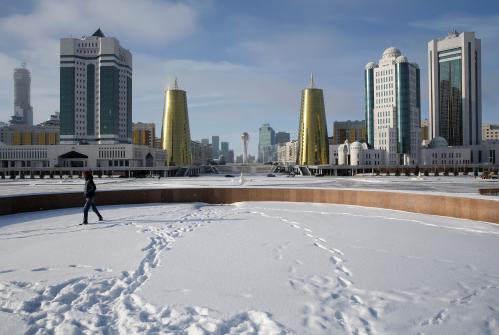Uzbekistan is in its second year of a wide-ranging market-oriented program of reforms. The government is making three fundamental shifts to the economy: from a command-and-control to a market-based economy; from a public sector-dominated to a private sector-driven economy; and from being inward-looking and isolationist to outward looking and open. These reforms are taking place amid growing external imbalances and a youth bulge that cannot be tackled without more jobs from the private sector.
It is challenging to navigate a transformation by shifting the role of the government from being the main allocator of resources to one of guiding and regulating markets to address informational asymmetries, dealing with externalities, providing public goods, and creating safety nets. For Uzbekistan to seize the new opportunities—from the digital economy, from Asia’s rising middle class, and from investments associated to the Belt-and-Road Initiative—Uzbekistan must close four development deficits: employment, enterprises, exports, and energy efficiency. We highlighted this in the forthcoming Country Private Sector Diagnostics.
Employment. Uzbekistan has a fast-growing working-age population and can use its labor force to drive growth. In 2017, Uzbekistan had a working-age population of about 23 million, which is 72 percent of its population. About 13 million participated in the labor force. By 2030, the labor force will increase by 4 million, making Uzbekistan’s the fifth largest in the Eastern Europe and Central Asia (ECA) region. But many in the working-age population are inactive, unemployed, or working abroad. Youth are especially discouraged—one in 10 people aged 20 to 24 are not even looking for work.
Enterprise. Most jobs are in agriculture and services, and state-owned enterprises (SOEs) dominate the formal sector. Four out of five workers work in agriculture and small-scale services, similar to the share of these sectors in GDP. One in three workers works in SOEs and one in three is self-employed. This results in a “missing middle” of medium-sized fast-growing companies, with the country still dominated by large underperforming SOEs and small firms, 70 percent of which do not employ any additional workers.
Exports. Uzbekistan’s export competitiveness has been deteriorating over the past decade. The poor business environment and distance to global markets have prevented Uzbekistan from integrating quickly into global value chains. Meanwhile, neighboring Kazakhstan’s competitiveness has increased by 14 percent, while in East Asia and Pacific (EAP) region it has grown by an average 42 percent. Uzbekistan’s weakening trade competitiveness represents a huge lost opportunity given the emergence of a growing consumer class in Asia. With an improved economic environment, Uzbek goods and services will have larger markets in Western Europe and East Asia to serve—and better conditions to reach them.
Energy Efficiency. Uzbekistan’s performs poorly in energy efficiency and is one of the most energy-inefficient economies in the world. Energy waste, water use, and CO2 emissions per unit of GDP, are among the highest globally. An inefficient chemical and petrochemical sector is a major contributor to this problem. Energy subsidies exacerbate environmental harm and, paradoxically, hamper other industries: low energy prices cause excessive consumption—especially during the winter—causing energy shortages.
Figure 1. Uzbekistan’s development deficits: Employment, Enterprise, Exports, Energy Efficiency
 Source: Country Private Sector Diagnostics, IFC, forthcoming
Source: Country Private Sector Diagnostics, IFC, forthcoming
In addressing these deficits, Uzbekistan is creating new opportunities for the private sector. These opportunities are strongest in tradable sectors which can generate more sustainable and higher-paying employment. The World Bank-IFC team looked at four parts of the economy which seem critical for Uzbekistan’s prosperity.
- As a land-locked country, air connectivity is critical for Uzbekistan. Travelers will not come by road or rail, and most of Uzbekistan’s produce, especially higher-value and perishable goods, needs reliable and competitive air transport and logistics. Uzbekistan has recently liberalized its visa regime. Now it needs to make Uzbekistan Airways competitive in a growing but cutthroat market, perhaps by modeling itself after Emirates and Singapore Airlines, both state-led companies. A key reform is unbundling functions—separating the airline, airport management, and air traffic control—and instituting an independent regulator. But first it must deal with a serious debt crisis.
- Uzbekistan’s nascent digital economy will require significant reforms and investment to build infrastructure that is universal and affordable. Governments worldwide have transformed telecoms from SOEs into vibrant digital growth sectors. But Uzbekistan is a laggard. It can build a robust skills base and use the experience of successful “new economy” Uzbek companies. Similar to air connectivity, unbundling functions and reducing the state’s footprint are key.
- The chemicals sector has great potential and is ripe for modernization. Uzbekistan is unique in having its own natural gas, potash, and phosphate ores critical for fertilizers, and producing methanol-derived products for manufacturing. This has made Uzbekistan a strong regional player. But the production of chemicals is also a creator of carbon emissions, making Uzbekistan one of the least energy-efficient countries in the world. Many quick wins in modernization and efficiency are at hand; the sector also has foreign companies participating in joint ventures with SOEs, and others interested in privatization. The modernization of chemicals will increase Uzbekistan’s competitiveness and make it more energy efficient.
- The horticulture sector is also important, as exports total $1 billion annually. However, Uzbekistan is not exploiting its comparative advantage. Eighty percent of exports are fresh produce for neighboring Kazakhstan and Russia. But Uzbekistan could be Asia’s “California” in terms of potential and distance to markets; it produces high-value foods that it could export to Europe and East Asia. In some cases, it has few competitors: East Asia’s cherries are supplied by California and Washington, while Turkey and Iran supply nuts and dried fruits to Europe. Uzbekistan exports to Russia and Kazakhstan because of proximity and lower quality thresholds, though margins are far higher in Europe and East Asia.
These ambitious reforms will bring enormous gains, but could also deliver many setbacks. Besides, they are not easy to start and sustain. But the payoff to being persistent is that Uzbekistan will achieve the goals of a more competitive, open, and wealthy society.










Commentary
How Uzbekistan is transforming into an open economy
December 20, 2018